Samsung's Galaxy S 4: Introduction & Hands On
by Anand Lal Shimpi on March 14, 2013 7:30 PM EST- Posted in
- Smartphones
- Samsung
- Mobile
- Galaxy S 4

Since 2010 Samsung has grown to become not only the clear leader in the Android smartphone space, but the largest smartphone manufacturer in the world. Its annual iteration of the Galaxy S platform is now arguably one of the most widely anticipated smartphone launches each year.
Like clockwork, tonight Samsung announced the Galaxy S 4: a 5-inch 1080p smartphone, and the new flagship for the Galaxy brand. We just finished learning about the device and spent a short time playing around with it.
Most of the hardware specs are known quantities. The 5-inch Super AMOLED display features a 1080p resolution, for a pixel density of over 441 ppi. The chassis is plastic with a metallic looking rim around the edge. Like most Samsung devices, the Galaxy S 4 feels well built although the plastic construction makes it the polar opposite of HTC's One - and truthfully in a different league altogether. I don't personally believe Samsung's use of plastics is terrible, but it definitely doesn't lend itself to the same sort of remarkable designs we see from HTC or Apple. On the plus side the SGS4 feels very light (it's even lighter than the SGS3). The tradeoff between material feel and weight is one that has a spectrum of solutions. Samsung remains on prioritizing weight and cost, which is understandable given the success the company has seen thus far.
The SGS4 feels surprisingly comfortable in hand, partly due to weight and party due to the device's proportions. I didn't mind the size at all.
The Galaxy S 4 is available in two colors: white frost and black mist. I played with an international SGS4 variant in white frost.
| Smartphone Spec Comparison | ||||||
| Apple iPhone 5 | HTC One | Samsung Galaxy S 3 | Samsung Galaxy S 4 | |||
| SoC | Apple A6 1.3GHz | Snapdragon 600 1.7GHz | Snapdragon S4 1.5GHz | Exynos 5 Octa (1.6/1.2GHz) or Snapdragon 600 1.9GHz | ||
| DRAM/NAND/Expansion | 1GB LPDDR2, 16/32/64GB NAND | 2GB LPDDR2, 32/64GB NAND | 2GB LPDDR2, 16/32GB NAND, microSD | 2GB LPDDR3, 16/32/64GB NAND, microSD | ||
| Display | 4.0-inch 1136 x 640 LCD | 4.7-inch SLCD3 1080p, 468 ppi | 4.8-inch Super AMOLED 720p, 306 ppi | 5-inch Super AMOLED 1080p, 441 ppi | ||
| Network | 2G / 3G / 4G LTE Cat 3 | 2G / 3G / 4G LTE Cat 3 | 2G / 3G / 4G LTE Cat 3 | 2G / 3G / 4G LTE Cat 3 (depending on region) | ||
| Dimensions | 123.8mm x 58.6mm x 7.6mm | 137.4mm x 68.2mm x 4mm - 9.3mm | 136.6mm x 70.6mm 8.6mm | 136.6mm x 69.8mm x 7.9mm | ||
| Weight | 112g | 143g | 133g | 130g | ||
| Rear Camera | 8MP | 4MP w/ 2µm pixels | 8MP | 13MP | ||
| Front Camera | 1.2MP | 2.1MP | 1.9MP | 2MP | ||
| Battery | Internal 5.45 Wh | Internal 8.74 Wh | Removable 7.98 Wh | Removable 9.88 Wh | ||
| OS | iOS 6.1.2 | Android 4.1.2 | Android 4.1.2 | Android 4.2.2 | ||
| Connectivity | 802.11a/b/g/n, BT 4.0, USB 2.0, GPS/GNSS | 802.11ac/a/b/g/n + BT 4.0, USB2.0, GPS/GNSS, MHL, DLNA, NFC | 802.11a/b/g/n, BT 4.0, USB 2.0, NFC, GPS/GNSS, MHL | 802.11a/b/g/n/ac (HT80) + BT 4.0, USB 2.0 NFC, GPS/GNSS, IR LED, MHL 2.0 | ||
The back cover remains removable, as does the 9.88Wh battery:
Internally, there’s 2GB of memory and 16 - 64GB of on-board NAND, with a microSD card slot for optional storage expansion.
As expected, the SoC will vary depending on region. Samsung will offer either its own Exynos 5 Octa or a 1.9GHz quad-core Snapdragon SoC from Qualcomm. Given the clock speed and the timing, I would assume Samsung is talking about a Snapdragon 600 but the only official word from Samsung is the 1.9GHz quad-core Snapdragon. Update: Qualcomm has confirmed that this is a Snapdragon 600.
The Exynos 5 Octa side is a bit more interesting. Samsung is calling the SoC a 1.6GHz Octa-core part, but that appears to be the clock speed for the four Cortex A7 cores. The four Cortex A15 cores will run at up to 1.2GHz, which should help keep power consumption manageable. We’ve been wondering for a while what clock speeds we’d see the Cortex A15s run at in smartphones, and I believe this is the first line drawn in the sand. If we go back to Samsung’s ISSCC disclosure of Exynos 5 Octa power consumption, it looks like peak CPU power consumption should be somewhere around 2W - definitely better than what we saw from Exynos 5 Dual in the Nexus 10. Again, no surprises here given that we’re talking about a smartphone - it’s just interesting to see. Update: There seems to be some confusion as to whether or not the A7/A15 clocks are 1.6/1.2 or 1.2/1.6. I was told the former and that's what I wrote down, but it's entirely possible that the information given wasn't correct. I'm awaiting for further confirmation. Although 1.2GHz makes sense for a max clock for the A15s, 1.6GHz is a bit high for A7s if they're truly to be used to keep power consumption down. I can see it working either way.
Samsung isn’t ready to talk specifics about what SoCs will end up in what regions. We weren’t allowed to run any downloaded applications or benchmarks on the hardware at the event, nor were we told what SoCs were used in the demo hardware. Both SoCs should be good choices though.
Similarly, there’s no disclosure on what baseband silicon is being used although LTE support will be offered depending on the region. It’s highly likely that we’re looking at another MDM9x15 with a discrete applications processor (Snapdragon or Exynos 5 Octa). All of the expected wireless connectivity options are present including 802.11ac and BT 4.0. Samsung is claiming support global LTE roaming (up to six different bands) and FDD/TDD LTE.
As is the norm these days the Galaxy S 4 comes with both a front and rear facing camera. The front facing camera features a 2MP sensor and is capable of recording video at 1080p30. The rear facing camera sees a move to a 13MP sensor with flash. No word on the max aperture or focal length of the camera systems at this point.
The Galaxy S 4 will ship with Android 4.2.2. It will be available both internationally and in the US starting sometime in Q2 (Update: first shipments will be in April). US operators signed up to carry the Galaxy S 4 are AT&T, T-Mobile, Sprint, Verizon, Cricket and US Cellular.


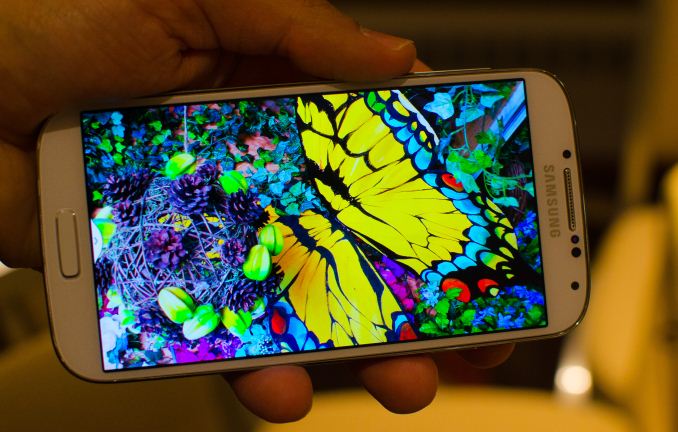
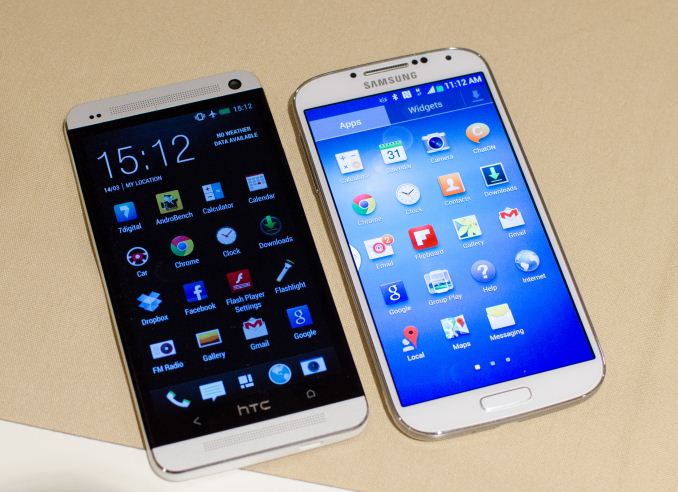

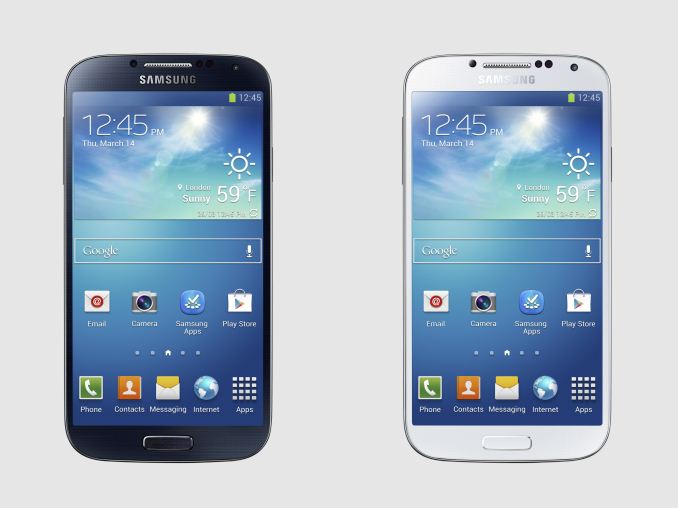
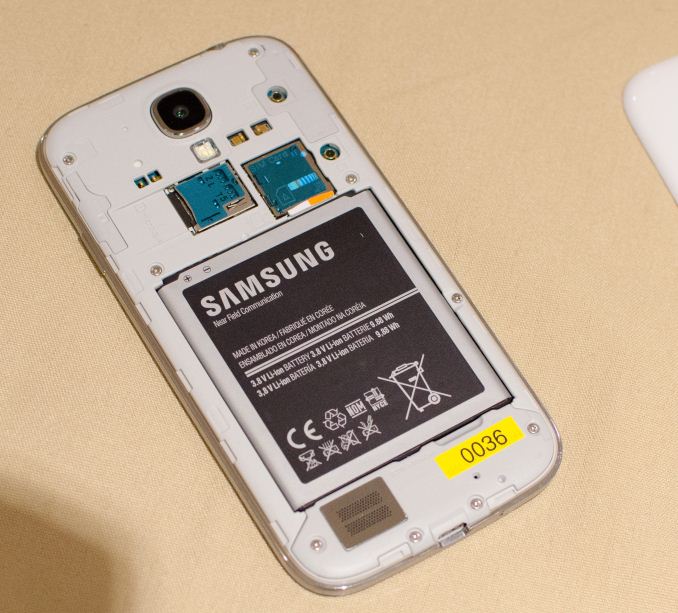
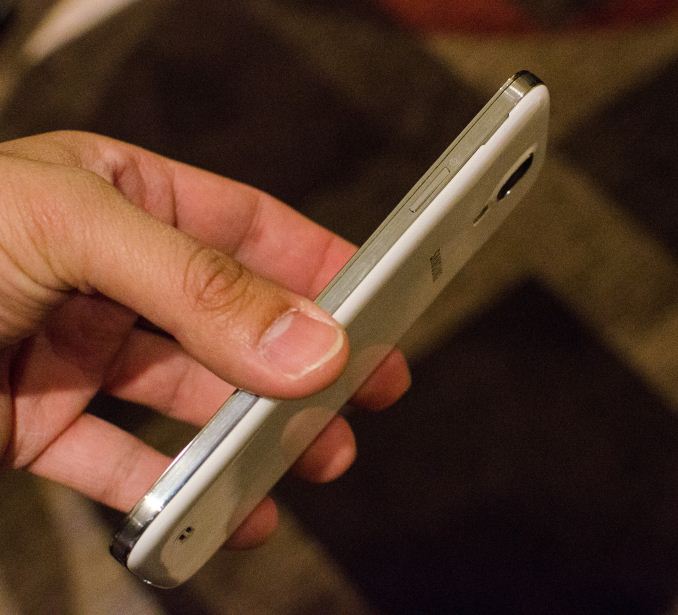















206 Comments
View All Comments
WritersBlock - Sunday, March 17, 2013 - link
For you it's not worth, for others it is.You guys are arguing the equivalent of favourite colour; it's subjective.
Samsung (like any other manufacturer) offer features in their products; each user decides which are benefits and which are features they don't need.
Tams80 - Wednesday, March 20, 2013 - link
Maybe I'm just not that popular, but at worst 5 minutes restarting my phone hardly makes a difference.treesloth - Wednesday, March 20, 2013 - link
The ones that are plug-and-use without cables are also of pretty short duration. The larger ones require a cable. A replaceable battery, though, restores the phone to 100% very quickly. Over the time I've had my Evo 3D, I've swapped batteries a couple of hundred times (lots of travel...) with no problems. No "sign in" or whatever you mean by that. If I happen to miss a call in the 2 minutes it takes to swap and restart, I get told as soon as it's done. Same with messages. Seriously, it's not difficult at all. I also have an 8,100 mAh portable charger. Love that, too. Both have their place.Relaxin - Friday, March 22, 2013 - link
I bike commute everywhere and not around a charger as often as I'd like. If I'm stranded somewhere with a dead battery I NEED to be able to swap in a charged spare battery. I think it's massively "understated" how beneficial a removable battery is.puremind - Saturday, March 16, 2013 - link
You shouldn't have to use a dock to do that!? How outdated? spare batteries nowadays can be charged while they are charging your phone...MicroUSB to recharge and USB to charge your smartphone. External battery is more convenient than 2 internal batteries, let alone it has bigger capacity allowing you to charge up your phone several times. A must-have!HJPJ - Friday, March 15, 2013 - link
I currently use an S2, and will be upgrading to the S4. If the S4 did not have a replaceable battery, that would have been a deal breaker for me. For my S2, I purchased two extended batteries (3400mAh) plus an external charger for them, from aliexpress.com - total cost: just a hair over $20, including shipping. I will be trying to duplicate this setup for my new S4.twurster - Saturday, March 16, 2013 - link
Blackberry figured this one out. the spare battery for the Z10 comes in a case with a micro usb in and out. Plug in the case to the wall and the phone to the case. Presto 2 charged batteries. The bonus being the spare doubles as micro usb power source and you can charge up with out removing the battery. From experience it takes about 2 minutes to swap from start to back online. And the price is reasonable at 50.00. I use this on my Z10 all the time and functionally have unlimited battery life. Now if I could just get a few more apps....leexgx - Saturday, March 16, 2013 - link
that's nice to know that they have done that with the new blackberry z10, as 3g is an killer on all phones i have used (i am still an blackberry buff)puremind - Saturday, March 16, 2013 - link
Wake up, this is 2013. There are better solution nowadays than removable batteries and MicroSD!!1. why would you want an inferior sized internal battery that requires you to open your device? As a customer I expect my batteries to be pluggable without having to open my device! Besides I expect spare batteries to have larger capacity than the internal battery. I can get that with a small battery coupled with microUSB to USB cable (the battery has a MicroUSB plug for input and a USB plug for output - simple!)
2. Likewise, nowadays storage is key. Just like I don't want to use floppy disks on my laptops anymore, I don't want to use MicroSD on my Smartphone! It has too low capacity. As a customer, I don't think I should have to use outdated storage technology. I much prefer MicroUSB OTG 128GB Flash Drive. It is fast and has bigger capacity.
The same USB to MicroUSB can be used to plug both the external battery and the Flashdrive! Both are extremely small devices and offer much more capacity than the traditional methods. I could not see myself go back to smaller storage or smaller battery sizes, so thank you Apple and HTC for moving away from outdated standards. It is human nature to cry when something is taken from them, but what we receive in exchange goes far beyond what we had previously!
Alexstarfire - Saturday, March 16, 2013 - link
Comparing internal devices to external devices is silly. It's like comparing laptops to desktops, or even all-in-ones. They simply serve different purposes.For what you can get for microSD and internal phone batteries I don't quite know why you are bashing it so hard.